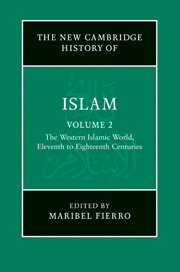Book contents
- Frontmatter
- Introduction
- PART I AL-ANDALUS AND NORTH AND WEST AFRICA (ELEVENTH TO FIFTEENTH CENTURIES)
- PART II EGYPT AND SYRIA (ELEVENTH CENTURY UNTIL THE OTTOMAN CONQUEST)
- 6 Bilād al-Shām, from the Fāṭimid conquest to the fall of the Ayyūbids (359–658/970–1260)
- 7 The Fāṭimid caliphate (358–567/969–1171) and the Ayyūbids in Egypt (567–648/1171–1250)
- 8 The Mamlūks in Egypt and Syria: the Turkish Mamlūk sultanate (648–784/1250–1382) and the Circassian Mamlūk sultanate (784–923/1382–1517)
- 9 Western Arabia and Yemen (fifth/eleventh century to the Ottoman conquest)
- PART III MUSLIM ANATOLIA AND THE OTTOMAN EMPIRE
- PART IV NORTH AND WEST AFRICA (SIXTEENTH TO EIGHTEENTH CENTURIES)
- PART V RULERS, SOLDIERS, PEASANTS, SCHOLARS AND TRADERS
- Glossary
- Bibliography
- Index
- References
6 - Bilād al-Shām, from the Fāṭimid conquest to the fall of the Ayyūbids (359–658/970–1260)
from PART II - EGYPT AND SYRIA (ELEVENTH CENTURY UNTIL THE OTTOMAN CONQUEST)
Published online by Cambridge University Press: 28 March 2011
- Frontmatter
- Introduction
- PART I AL-ANDALUS AND NORTH AND WEST AFRICA (ELEVENTH TO FIFTEENTH CENTURIES)
- PART II EGYPT AND SYRIA (ELEVENTH CENTURY UNTIL THE OTTOMAN CONQUEST)
- 6 Bilād al-Shām, from the Fāṭimid conquest to the fall of the Ayyūbids (359–658/970–1260)
- 7 The Fāṭimid caliphate (358–567/969–1171) and the Ayyūbids in Egypt (567–648/1171–1250)
- 8 The Mamlūks in Egypt and Syria: the Turkish Mamlūk sultanate (648–784/1250–1382) and the Circassian Mamlūk sultanate (784–923/1382–1517)
- 9 Western Arabia and Yemen (fifth/eleventh century to the Ottoman conquest)
- PART III MUSLIM ANATOLIA AND THE OTTOMAN EMPIRE
- PART IV NORTH AND WEST AFRICA (SIXTEENTH TO EIGHTEENTH CENTURIES)
- PART V RULERS, SOLDIERS, PEASANTS, SCHOLARS AND TRADERS
- Glossary
- Bibliography
- Index
- References
Summary
The geo-political background
The old divisions of ajnād or military government created by the Umayyads and completed by the ʿAbbāsids were still being used in the middle of the seventh/thirteenth century by the Aleppan writer ʿIzz al-Dīn ibn Shaddād to describe Bilād al-Shām: these were Jordan, Palestine, Damascus, Ḥimṣ and Qinnasrīn. The border areas, called ‘ʿawāṣim’, between Antioch and Samosata formed the northern limit of this area, a border which changed over the centuries. The Euphrates was, in theory, the eastern border, but from the fourth/tenth to the seventh/thirteenth century, northern Syria and Upper Mesopotamia (Jazīra) remained closely linked. Politically the two areas were often under the same power or different branches of the same family, while, economically, a highly important trade route linked Baghdad to the Mediterranean through the Euphrates valley to Aleppo and then Antioch. Other routes went from Mosul to Aleppo passing through the western part of Upper Mesopotamia.
Southern Syria and Palestine were also linked to Baghdad by the Euphrates route as far as Raḥba, then across the steppe to Palmyra, Damascus and the Palestinian coast. Damascus was closely linked to Egypt by the Mediterranean coast and the south of Palestine. When the settlement of the Franks in this area made this route difficult, it was temporarily replaced by the Sinai route, allowing access from Syria to Egypt via Transjordania.
- Type
- Chapter
- Information
- The New Cambridge History of Islam , pp. 159 - 200Publisher: Cambridge University PressPrint publication year: 2010



